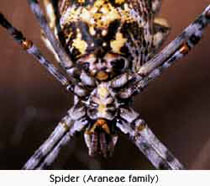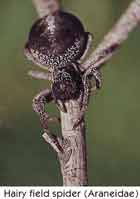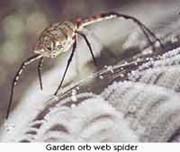|
 Kevin Thompson Kevin Thompson
It’s a dark, stormy night. The hero is lured into an old, dilapidated and possibly haunted house. He enters the house and finds there is no electricity; his only source of light is a torch. He creeps through the huge entrance hall towards the creepy, spiral staircase. As he approaches the staircase he suddenly twitches and gets caught up and entangled in, yes, a huge spider-web.
This scenario is not only used in films, but also in books, comics and dramatised radio programmes. It always seems to touch a nerve with the audience because most people seem to have a fear or dislike of spiders. A herpetologist I know has no problem working with snakes but shudders at the thought of working with or even having to touch spiders.
 Blow away the cobwebs? Blow away the cobwebs?
One of the first things people will do when moving into a new house or after having been away, is to dust away all the cobwebs suspended from various walls and ceilings around the house. As summer approaches, they will then complain that there are too many pest insects around the house. Spiders are among the most misunderstood animals about the house and garden. Not only do they have beautiful colourings, patterns and shapes, but they also fulfil an important ecological niche and their presence should be encouraged.
Useful Allies Indeed
The jumping spider, family Salticidae, is a common visitor to homes in Arabia. These spiders often have striking patterns on their bodies and are able to jump at their prey. Just before jumping though they lay down a disc to which they attach silk thread. This acts as a 'safety harness' so if they miss their prey, they don't fall to the ground. Food for the jumping spider is mainly flies and mosquitoes - so they are great to have around!
 Orb-web spiders, family Araneidae, will spin beautiful geometric webs between plants in order to catch their prey. These spiders are usually brightly coloured and quite striking when viewed up close. The family is divided into the garden orb web spiders, Argiopinae, and the typical orb-weavers, the Araneidae, such as the hairy field spider. Orb-web spiders, family Araneidae, will spin beautiful geometric webs between plants in order to catch their prey. These spiders are usually brightly coloured and quite striking when viewed up close. The family is divided into the garden orb web spiders, Argiopinae, and the typical orb-weavers, the Araneidae, such as the hairy field spider.
Other efficient predators found in the garden are the small crab spiders, Thomisidae. These spiders are coloured to blend in with their surroundings and are capable of catching prey larger than themselves. The prey usually being pest species such as flies.
So next time 'the hero' is entangled in the spider web, think about how much time and energy the spider took to make the web and how useful it would be in catching unwanted household pests. (Or the director?)
ALIEN INVADER
The black widow spider, Latrodectus sp., an introduced species from Australia (brought in along with shipments of wood), is amongst the few venomous spiders that can be found in Arabia. These spiders rarely exceed 1 cm in length and are usually very shy, remaining in dark, humid areas of the house or garden. They are rarely aggressive and will only bite if cornered or agitated.
However, unlike other spiders their presence in the home should not be encouraged. If a black widow spider is found, and positively identified (very important), it should be removed and killed using a broom or similar object. Do not use your bare hands. Take care to also remove the egg sac, which is a white silk ball attached to the web.
All material on this page is copyrighted by Trident Press Ltd and/or individual contributors.
Unauthorised use of photographs or text is strictly prohibited.
|
|

